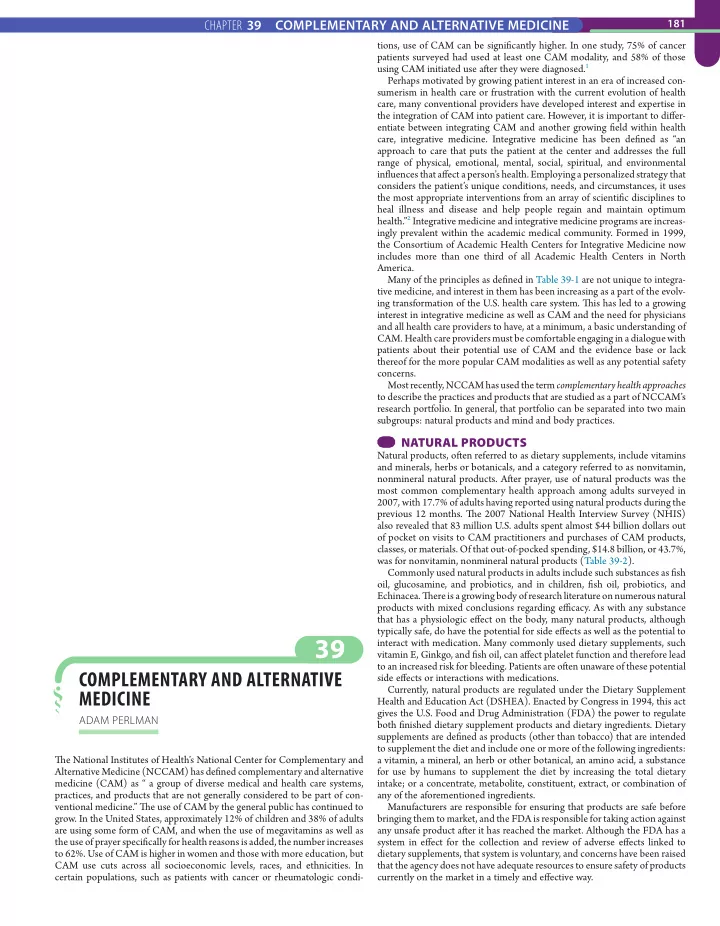

181 CHAPTER 39 COMPLEMENTARY AND ALTERNATIVE MEDICINE tions, use of CAM can be signifjcantly higher. In one study, 75% of cancer patients surveyed had used at least one CAM modality, and 58% of those using CAM initiated use afuer they were diagnosed. 1 Perhaps motivated by growing patient interest in an era of increased con- sumerism in health care or frustration with the current evolution of health care, many conventional providers have developed interest and expertise in the integration of CAM into patient care. However, it is important to difger- entiate between integrating CAM and another growing fjeld within health care, integrative medicine. Integrative medicine has been defjned as “an approach to care that puts the patient at the center and addresses the full range of physical, emotional, mental, social, spiritual, and environmental infmuences that afgect a person’s health. Employing a personalized strategy that considers the patient’s unique conditions, needs, and circumstances, it uses the most appropriate interventions from an array of scientifjc disciplines to heal illness and disease and help people regain and maintain optimum health.” 2 Integrative medicine and integrative medicine programs are increas- ingly prevalent within the academic medical community. Formed in 1999, the Consortium of Academic Health Centers for Integrative Medicine now includes more than one third of all Academic Health Centers in North America. Many of the principles as defjned in Table 39-1 are not unique to integra- tive medicine, and interest in them has been increasing as a part of the evolv- ing transformation of the U.S. health care system. Tiis has led to a growing interest in integrative medicine as well as CAM and the need for physicians and all health care providers to have, at a minimum, a basic understanding of CAM. Health care providers must be comfortable engaging in a dialogue with patients about their potential use of CAM and the evidence base or lack thereof for the more popular CAM modalities as well as any potential safety concerns. Most recently, NCCAM has used the term complementary health approaches to describe the practices and products that are studied as a part of NCCAM’s research portfolio. In general, that portfolio can be separated into two main subgroups: natural products and mind and body practices. NATURAL PRODUCTS Natural products, ofuen referred to as dietary supplements, include vitamins and minerals, herbs or botanicals, and a category referred to as nonvitamin, nonmineral natural products. Afuer prayer, use of natural products was the most common complementary health approach among adults surveyed in 2007, with 17.7% of adults having reported using natural products during the previous 12 months. Tie 2007 National Health Interview Survey (NHIS) also revealed that 83 million U.S. adults spent almost $44 billion dollars out of pocket on visits to CAM practitioners and purchases of CAM products, classes, or materials. Of that out-of-pocked spending, $14.8 billion, or 43.7%, was for nonvitamin, nonmineral natural products (Table 39-2). Commonly used natural products in adults include such substances as fjsh oil, glucosamine, and probiotics, and in children, fjsh oil, probiotics, and Echinacea. Tiere is a growing body of research literature on numerous natural products with mixed conclusions regarding effjcacy. As with any substance that has a physiologic efgect on the body, many natural products, although typically safe, do have the potential for side efgects as well as the potential to interact with medication. Many commonly used dietary supplements, such 39 vitamin E, Ginkgo, and fjsh oil, can afgect platelet function and therefore lead to an increased risk for bleeding. Patients are ofuen unaware of these potential COMPLEMENTARY AND ALTERNATIVE side efgects or interactions with medications. Currently, natural products are regulated under the Dietary Supplement MEDICINE Health and Education Act (DSHEA). Enacted by Congress in 1994, this act gives the U.S. Food and Drug Administration (FDA) the power to regulate ADAM PERLMAN both fjnished dietary supplement products and dietary ingredients. Dietary supplements are defjned as products (other than tobacco) that are intended to supplement the diet and include one or more of the following ingredients: Tie National Institutes of Health’s National Center for Complementary and a vitamin, a mineral, an herb or other botanical, an amino acid, a substance Alternative Medicine (NCCAM) has defjned complementary and alternative for use by humans to supplement the diet by increasing the total dietary medicine (CAM) as “ a group of diverse medical and health care systems, intake; or a concentrate, metabolite, constituent, extract, or combination of practices, and products that are not generally considered to be part of con- any of the aforementioned ingredients. ventional medicine.” Tie use of CAM by the general public has continued to Manufacturers are responsible for ensuring that products are safe before grow. In the United States, approximately 12% of children and 38% of adults bringing them to market, and the FDA is responsible for taking action against are using some form of CAM, and when the use of megavitamins as well as any unsafe product afuer it has reached the market. Although the FDA has a the use of prayer specifjcally for health reasons is added, the number increases system in efgect for the collection and review of adverse efgects linked to to 62%. Use of CAM is higher in women and those with more education, but dietary supplements, that system is voluntary, and concerns have been raised CAM use cuts across all socioeconomic levels, races, and ethnicities. In that the agency does not have adequate resources to ensure safety of products certain populations, such as patients with cancer or rheumatologic condi- currently on the market in a timely and efgective way.
Recommend
More recommend